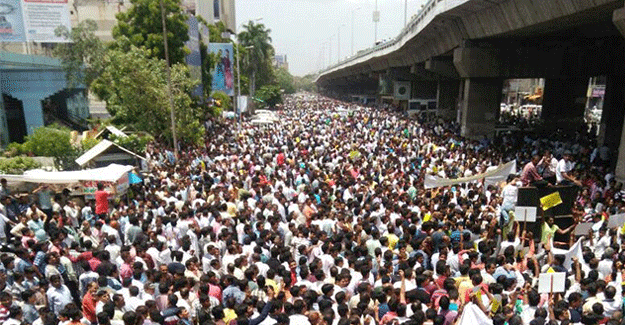
Garment Exporters Cry Foul On Centre’s Move To Reduce Duty Drawback Drastically From Oct 1
Cutting across sections, the textile industry reacted sharply to the steep decline in duty drawback rates announced by the Finance Ministry with effect from October 1. The entire gamut of garment manufacturers was up in arms against this government move contending that it went against the grain of boosting exports in the textile sector.
To begin with the apparel industry expressed extreme disappointment on the announcement of the steep cut in duty drawback percentages for export of readymade garments. A cursory glance at the rates, which the government announced on the evening of September 23 send the textile segment into a pall of gloom. The All India Rates (AIR) was reduced from 7.7 percent to 2 percent.
The Apparel Export Promotion Council (AEPC) reacted sharply stating, “The low rate announced by the government is unexpected. We are subject to this body blow even as our industry is facing a continuous decline in exports due to global conditions which include rupee overvaluation and the uncertainties posed by the GST regime.”
The Council claimed that the industry was already facing severe financial pressure due to the increased working capital requirements under the GST regime. Consequently, the industry felt over-stressed and the export sentiment was very low.
Terming the duty drawback as one of the key policy support measures to boost the cost competitiveness of the Indian textile industry, the Council said that this sharp reduction in drawback rates will now augment the adverse circumstances the industry finds itself in and drive it into further distress.
The AEPC expressed the sentiment, “With this steep decline in the drawback support, over 7000 small and medium enterprises in the apparel exports will be crippled and doomed in uncertainties. This will have an adverse impact on the employment being provided to over 12 million people in the textile industry sector.”
Ashok G Rajani, Chairman AEPC, stated, “The apparel industry needs to book orders in advance for the next season. The uncertainty prevailing for the last three months regarding the GST rates on apparel and job work have already cost the industry's order books. I think the present new rates are unacceptable and the ministry of textiles should immediately consider AEPC’s recommendation for extending the current transition rates till 31st March 2018, to instill confidence in the sector and also ensure a smooth transition into GST. This will also sustain employment in the sector.”
“In the absence of an encouraging drawback rates, the exports will further witness a sharp decline just ahead of the peak festival season when the industry was expecting recovery,” he concluded.
AEPC has been in constant consultation with the Drawback Committee and various ministries for identification and consideration of several embedded or blocked taxes which are presently not subsumed in GST, not considered in the drawback, and hence a loss to the exporters. The industry was expecting continuation of the present drawback rates till such time as these consultations could be completed and proper measures taken to ensure that exports remain zero rated and no taxes are exported.
Down south, the reactions were much more vitriolic and adverse as the Coimbatore and Tirupur textile segments cried foul at being hit below the belt. The reduction in tax refunds which will be applicable from October 1, prompted industry honchos from the southern belt to urge the government to reconsider their decision. The garment factory owners pointed out that the neighboring hub of Tirupur will be very badly affected by this decision and it would have adverse impact on the country’s economy.
Tirupur Exporters’ Association president, Raja M Shanmugham stated, “Our export segment would be adversely affected by this reduction in rate from 7.6 percent to 2 percent for knitwear.”
“This move has come as a rude shock to us exporters. The shock is accentuated by the fact that we are already facing stiff competition in the global markets. The government will need to take another look at their decision in wake of this,” he opined.
He dwelt on the buyers’ mindset. He said, “Once the buyers exit the Indian market owing to high prices, it would be a gigantean task to get their loyalty back. This is so because buyer psychology would be to adhere to competitor countries like Sri Lanka, Vietnam, Bangladesh and Cambodia as a safer bet against uncertainties.”
He also spelt out his apprehension over severe crisis generated by massive job losses. He pointed out that nearly 80 percent of the garment industry fell under the category of small and medium enterprises He implied that such units would be forced to shut shop.
Newly elected chairman of Southern India Mills Association (SIMA) P Natraj also pitched in for a relook by the government. He made an appeal to the Finance Minister to re-consider the decision taken on rates applicable to the textile industry.
Natraj also stated that the union finance ministry must take appropriate measures to effect refund of all the blocked and embedded taxes, levies and accumulated input tax credit on fabrics. He emphasized that the government should also take the same steps for processed fabric and should announce an export stimulus.
“The government had earlier talked about boosting exports and creating jobs in the textile sector. However, this move is totally discordant with the intention averred,” he concluded.
Textile Excellence
If you wish to Subscribe to Textile Excellence Print Edition, kindly fill in the below form and we shall get back to you with details.








